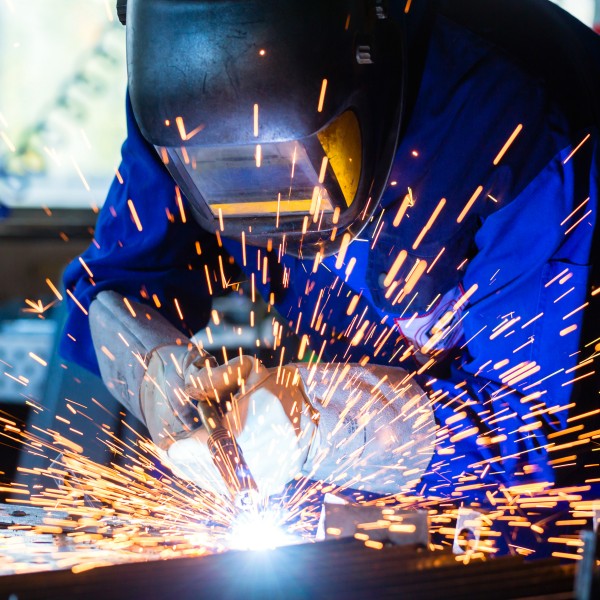Fume collector systems can help reduce harmful weld fumes in your facility. This important equipment is designed to draw in contaminated air, filter out particulates and return cleaner air to the shop interior or discharge it outdoors. Proper monitoring and maintenance are critical to the performance of these systems – including replacing filters at the appropriate times. Some of today’s systems feature automated monitoring to help keep the collector operating at its peak.
How Will I Know if the Entire Extraction System is Working as a Whole?
While the collector is an important part of the system, it can only filter the air brought into it through a well-designed network of strategically placed hoods and ducts. To help ensure the entire system is integrated and functioning properly, identify and monitor exposure zones around the workers and emissions in the air being discharged from the facility.
Also work with an industrial hygiene professional to sample and test the air in all worker breathing zones to help monitor exposure on site. To monitor emissions, involve an air quality expert or use a particulate monitor to accurately test the discharged air from your facility.
Once design issues are addressed, you can monitor the collector to confirm it’s filtering the required percentage of contaminants from your facility’s air. Most collectors incorporate a differential pressure (dP) indicator that can assist with the identification of basic maintenance needs, such as filter issues or change-outs. The greater the pressure drop, the harder the system has to work to pull air through the filters. Regular monitoring of your collector’s dP readings can help establish valuable operational data patterns to help you optimize your collector’s performance.


How Will I Know When to Replace Filters?
While it’s helpful to track the number of hours your filters are actually in use, changing them on a set schedule is not always ideal. Instead, monitoring your collector’s dP data will help you better estimate actual filter conditions and allow you to replace them when they’re fully loaded. This helps ensure you’re getting maximum service life from the filter elements.
Your ideal dP will depend on your equipment and your process, but typically, a “normal” range is between two and four inches of water column. At the high end, the equipment’s self-cleaning function turns on and uses compressed air to pulse dust off the filters. In manually cleaned extractors, filters are cleaned during planned downtime. When pulsing or manual cleaning no longer restores normal dP, the filters should be replaced. A remote monitoring service can quickly identify and flag these incidents for quick action. A combination of the two practices provides a good safeguard to keep processes up and running without interruption.

Am I Using the Right Filters?
If you believe your filters are delivering shorter life than you expected, it may be time to evaluate and upgrade the filter media in your extractor. Several key factors can help determine the right filter elements for your operations. These considerations include:
Particulate Type and Volume — Sub-micron weld fume particles are best captured by fine-fiber filter media specifically designed for this application. However, if your operation expands beyond welding to metal fabricating or coarse grinding, you may want to consider alternate media substrates designed for your application like synthetic, spun-bond conductive, or high-temperature versions. Most of these substrates come in a fine-fiber version to optimize filter efficiency.
Process Criticality — The types of material you process and the resulting particulates will determine the ideal amount of filter media for your application. Additionally, processes that run intermittently and have the ability to clean filters during downtime require a different media type than those with continuous operating processes. Your dust collector manufacturer can help recommend the appropriate filter type and size to meet your unique filtration needs.
Cost Management Goals — When replacing filters, an upgrade to fine-fiber media can potentially lead to long-term cost savings as a result of longer service life, reduced maintenance, lower energy consumption, and improved air quality.

Is There an Easier Way to Monitor Dust Collection Equipment?
Production capacity, staffing issues and job demands make it a challenge for any operation to manually monitor their fume extraction equipment with any regularity. Thankfully, the Industrial Internet of Things (IIoT) has made its way to dust collection equipment, too. Today, through the use of several strategically placed sensors on the dust collection system, plant managers can establish operational parameters for their equipment and remotely track the performance of their collectors via proprietary monitoring software and internet connectivity. Whether working in the facility or working remotely, access to real-time data for your collector – or a whole network of collectors – is available for most makes and models today.
Summary
Fume extraction systems play a central part in your welding operation, so it’s important to stay in tune with the condition and performance of your plant equipment. With ongoing monitoring of system performance, timely filter replacements, and filter upgrades when needed, you can reduce risks and lower the total operating costs in your facility.
Articles




